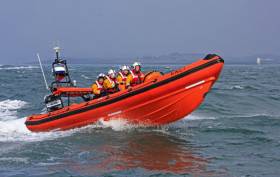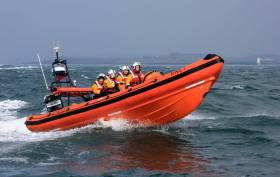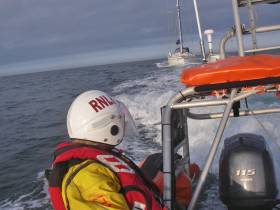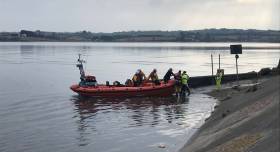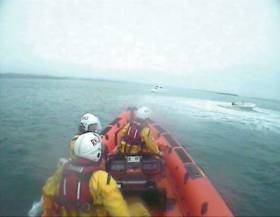Displaying items by tag: Portaferry
Portaferry RNLI launched to the aid of a fishing vessel with three on board which suffered engine failure on Strangford Lough yesterday afternoon (Saturday 20 April).
Volunteers were paged while taking part in in a ‘crew day’, whereby they gathered to clean down the lifeboat and station, after reports that a boat had suffered engine failure one mile from Strangford Narrows.
The lifeboat launched at 2.50pm in sunny weather conditions with good, clear visibility and little wind.
When they arrived on scene at 3.03pm, they established a tow line and proceeded to the nearest and safest mooring point at Cook Street quay in Portaferry.
The volunteer crew then handed the fishing boat and its crew over to HM Coastguard, and returned to station at 4:15pm.
Commenting on yesterday’s rescue, Simon Rogers, Portaferry RNLI lifeboat operations manager, said: “The hard work and dedication of our volunteers has once again resulted in the safe return to shore of the skipper and his crew who were having trouble while at sea.
“He certainly took the right course of action calling for help once he realised that his engine had failed.
“We are all delighted with the outcome and urge anyone considering going on the water to take all necessary precautions. It has been a busy week for the volunteers.”
A volunteer crew from Portaferry RNLI launched to a 999 call in the early hours of Sunday morning (14 April) reporting that a yacht with three people on board had hit rocks at Rainey Island near Ballydoran in Strangford Lough.
The lifeboat launched at 1.50am in cloudy weather conditions with good visibility and Force 4 south-easterly winds. The Portaferry crew arrived on scene 35 minute later with good visibility and a moderate sea state.
When the volunteer crew arrived on scene, they found that the yacht had made itself off the rocks and proceeded into Strangford Lough Yacht Club.
Portaferry RNLI closely followed the boat to the pontoon, went alongside yacht and checked that all onboard were safe and well before returning to station at 3.35am.
Two Callouts In 24 Hours Keep Portaferry Lifeboat Volunteers Busy
#RNLI - Yesterday evening (Saturday 15 September) at 4.45pm, a volunteer RNLI crew from Portaferry launched to the aid of two men in trouble in the water just off Ballyhenry Island.
The two men had been using a personal watercraft when one of them had fallen from the vessel and was struggling to get back to it.
The second man, realising that the first was in difficulty, started to swim from the shore to try and help at the small island, around 1.5 miles north of Portaferry on the eastern shore of Strangford Lough in Co Down.
At the time, the weather was cloudy with good visibility, a southerly wind and calm seas.
Portaferry RNLI launched at 4.50pm and 10 minutes later were on scene, where the lifeboat crew took both men on board before returning them to Cooke Street Quay in Portaferry and into the care of the Portaferry Coastguard team.
The second launch was this morning (Sunday 16 September) in response to a Mayday call regarding an angler who had fallen from rocks into the sea just off Ardglass Golf Course.
Pagers sounded at 8.36am and the crew were on the water six minutes later, arriving on scene at 9.10am.
Weather conditions at the time were overcast with good visibility, a south-westerly Force 3 wind and moderate seas.
The male casualty had in the meantime been picked up by a local boat and returned to shore at Ardglass Marina. The lifeboat continued to the marina where they administered casualty care before leaving him in the care of the local coastguard team at 9.40am.
Commenting on the weekend’s events, Portaferry RNLI lifeboat operations manager Simon Rogers said: “We can go for weeks without any callouts, but during those quiet periods our volunteer boat and shore crew members train hard every week, preparing for situations such as this.
“It is thanks to their dedication and hard work that we are able to respond so quickly an as often as required to help those in trouble at sea.”
Busy Sunday For RNLI Lifeboats At Lough Derg, Baltimore & Portaferry
#RNLI - Lough Derg RNLI assisted four people after their boat ran aground when they took a wrong turn above Victoria Lock on the River Shannon yesterday (Sunday 9 September)
Water levels at the casualty vessel’s location were very low when the lifeboat arrived at 2.11pm, a little over an hour after launch.
All four on board the casualty boat were safe and unharmed. The skipper had dropped anchor as there was a strong flow, combined with wind, at the location.
While the vessel had sustained damage to its propellers and drive, its hull was not holed.
The lifeboat took the casualty vessel under tow back to the main navigation channel and onwards to Shamrock Marina at Banagher, the closest safe harbour and where the vessel had a mooring at which it was safely tied alongside at 4pm.
Peter Kennedy, deputy launching authority at Lough Derg Lifeboat Station, advises boat owners to carry up-to-date charts and to familiarise themselves with the buoyage on the Shannon.
Meanwhile, Baltimore RNLI launched their inshore lifeboat around 2.50pm to a sailing sloop that had filled with water near the West Cork harbour.
Within three minutes the inshore lifeboat reached the casualty boat, a 6m sailing vessel with two on board which had been caught up on pot buoys and knocked over by a strong gust.
Another RIB with a Baltimore lifeboat crew member was an ready on standby as the sailors bailed out their vessel, and after helping to speed up the process, they soon had the boat clear of water and ready to sail back to Baltimore Harbour unassisted.
Much earlier on Sunday, Portaferry RNLI were part of the multi-agency response to a Mayday call from a lone sailor on a 20m act grounded at Phennick Point near Ardglass in Co Down.
Due to the vessel’s position on dangerous rocks and with fishing gear in the area, only Portaferry’s inshore lifeboat was small enough to manoeuvre through the rocks and rough seas to retrieve the sailor and transfer him safety to Ardglass Marina.
#RNLI - Portaferry RNLI’s volunteer crew were paged yesterday afternoon (Saturday 11 August) to go to the aid of two people stranded on Guns Island off Co Down.
The lifeboat launched at 3:20pm in overcast weather with good visibility and a Force 4 south-easterly wind but a rough sea state, and on arrival on scene 20 minutes later it was raining with poor visibility.
Newcastle, Bangor and Portaferry coastguard rescue teams were also in attendance, assisting from the shore.
The RNLI crew approached the scene where they rescued the two people and their dog from the island, where they were stranded after their six-metre punt got into difficultly and was destroyed on nearby rocks.
The casualties were taken to Ballyhornan Beach where they were transferred to the care of the coastguard rescue teams on shore.
Elsewhere, Clifden RNLI added to their busy August with a callout to a yacht with engine trouble both of Slyne Head on Friday afternoon (10 August).
A light Force 2 north-westerly wind made the yacht’s passage to Clifden slow going under sail alone. The Clifden lifeboat crew established a tow to Clifden Bay, which took over an hour, and the D-class lifeboat aided in mooring the yacht.
“Once on the mooring, a rope could be observed caught underneath the yachts hull and an attempt was made to release it. This proved unsuccessful but explained how the yacht had lost mechanical propulsion,” said Clifden RNLI coxswain David Barry.
Portaferry Lifeboat Rescues Lone Sailor On Stricken Yacht
#RNLI - Pagers sounded yesterday (Wednesday 11 April) for the volunteers from Portaferry RNLI to assist a man onboard an 18ft yacht experiencing problems off the Co Down coast.
The yachtsman was two miles from the entrance to Strangford Lough when he got into difficulty.
Portaferry’s volunteer crew launched their inshore lifeboat at 2.33pm in cloudy conditions, with good visibility and a Force 4-5 easterly wind.
Sea conditions at the time of launch were moderate, but when the RNLI crew arrived on scene at 2.50pm, they were met by very rough seas and large swells.
Having assessed the situation, the lifeboat helm deemed that it would be too dangerous to attempt a tow due to the extremely challenging conditions they were experiencing. Instead, a volunteer crew member was put on board the casualty vessel to help sail it into Ardglass Harbour.
Also in attendance were a volunteer crew from Newcastle RNLI onboard their all-weather lifeboat, standing by to offer assistance if required.
The Portaferry lifeboat then escorted the casualty vessel to the safety of the pontoons at Ardglass and into the hands of the Newcastle Coastguard team.
Commenting on the rescue, Portaferry RNLI lifeboat operations manager Simon Rogers said: “Our volunteer crew faced challenging conditions during this rescue, encountering extremely rough sea conditions. The man onboard the casualty vessel did the right thing calling for help before things got out of hand.
“We would like to stress at this time, when more and more boats are returning to the water, that everyone planning any sea trip [should] respect the water and take all necessary precautions.”
Portaferry Lifeboat Rescues Man & His Dog On Stricken Yacht
#RNLI - A volunteer crew from Portaferry RNLI were paged yesterday afternoon (Monday 12 March) to go to the aid of a man on a yacht experiencing engine problems.
The man was travelling on his 13-metre yacht from Bangor to Ardglass when his engine failed some six miles off the Co Down coast west of Cloughey.
The crew launched their Atlantic 85 lifeboat Bluepeter V at 3.55pm, just 10 minutes after being paged, and arrived at the casualty vessel at 4.38pm. Weather conditions at the time were sunny with good visibility, a slight north-northeast wind and calm seas.
Once on scene, one of the volunteer RNLI crew went on board the yacht with its pilot, and a tow line was established to bring them back safely to Strangford an hour later, safety returning the yachtsman and his dog to shore.
Simon Rogers, Portaferry RNLI lifeboat operations manager, said: “The hard work and dedication of our volunteers has once again resulted in the safe return to shore of this man who was having trouble while at sea.
“He certainly took the right course of action calling for help once he realised that his engine was failing. We are all delighted with the outcome and urge anyone considering going on the water to take all necessary precautions.
“It has been a busy week for the volunteers at this station with four shouts in the past week. Anyone who would like any information on safety on the water can find further details on our website RNLI.org.”
#RNLI - Yesterday afternoon (Tuesday 6 March), a volunteer crew from Portaferry RNLI was tasked to go the aid of a woman stranded on one of Strangford Lough’s many islands.
The woman had been walking her dog on Rough Island, a small island which lies just off Island Hill between Newtownards and Comber in Co Down.
The island is accessible on foot at low tide via a concrete causeway connecting the mainland to the small island. However, the woman had been cut off when the causeway became submerged by the incoming tide.
Weather conditions at the time were partly cloudy with good visibility, and the volunteer RNLI crew were quickly on scene.
The woman and her dog were then taken on board the lifeboat and transported the short distance to shore and into the safe hands of the waiting Bangor Coast Guard team.
#RNLI - A volunteer crew from Portaferry RNLI were preparing for a training exercise yesterday morning (Saturday 14 October) when they received a call to go to the aid of a man who had been thrown from a small motor boat which was subsequently spinning out of control in Strangford Lough.
The call was received at 10.53am and the volunteer lifeboat crew were on the water and on their way to the casualty by within two minutes, heading for a location roughly half a mile from Don O’Neill Island.
Weather conditions were cloudy with fair visibility, a Force 3 southerly wind and calm sea conditions.
On arrival at 11am, the volunteer crew learnt that the man had been thrown clear of the small dory when the craft had developed steering problems and started spinning in circles.
He was then lifted on board another boat which had been at the scene at the time, and taken ashore by them.
With the help of other boats attending a regatta in the area at the time, the Portaferry RNLI crew eventually brought the spinning craft under control, after which they attached tow lines to the vessel and towed it back into Portaferry Marina.
#RNLI - Portaferry RNLI was called out yesterday afternoon (Wednesday 28 June) to rescue a group of four people who had become stranded on an island at the north end of Strangford Lough.
The two women and two children had become stranded on Rough Island, a small island which lies just off Island Hill in Strangford Lough between Newtownards and Comber in Co Down.
The island is accessible on foot at low tide via a concrete causeway connecting the mainland to the small island. However, the group had been cut off when the causeway submerged with the incoming tide.
The coastguard request to launch was received by Portaferry RNLI at 4.34pm and the volunteer lifeboat crew were on the water six minutes later, arriving on scene at 5.06pm.
Weather conditions at the time were partly cloudy with good visibility and calm seas.
The women and children were taken on board the lifeboat and transported the short distance to safety on shore. Once satisfied they were out of danger, the lifeboat crew returned to station ready for service.































